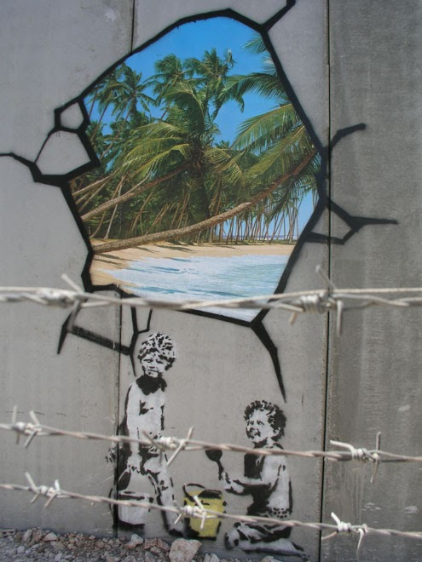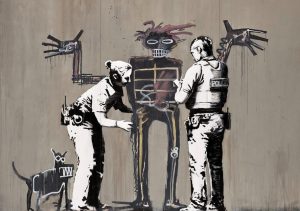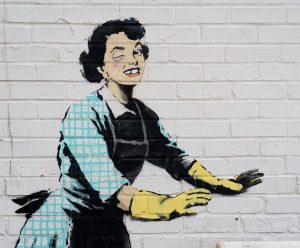The Segregation Wall
Palestine, August 2005

Credit Photo: Banksyblog
Palestine is now the world’s largest open-air prison and the ultimate activity holiday destination for graffiti artists.
In August 2005, Banksy visited Palestine where he painted with his team 7 large murals on the West Bank Wall also referred to as the Segregation Wall.
The security barrier separating the occupied territories from Israel is over 450 miles long and 38ft high. It was deemed illegal by the International Court of Justice but construction by the Israeli government continues.
Banksy Painting in West Bank, Palestine (2005)
Banksy’s feelings about the barrier are made explicit in a statement which says the wall “essentially turns Palestine into the world’s largest open prison.”
On Banksy’s website, readers are reminded that Israel’s 425-mile-long West Bank barrier, separating Israel from the Palestinian territories, is considered illegal by the United Nations.

Segregation Wall, Palestine 2005, Wall and Piece p.138
This mural depicts two young boys playing with buckets and shovels, like children creating sandcastles on a beach. The boys, one standing, the other kneeling, look back at the viewer, rendered in Banksy‘s typical black and white stencil aesthetic. Just above the boys, the artist has created the illusion of a broken section of the grey wall on which the mural was created. Through this false opening through the wall painted as a trompe-l’oeil, a photorealistic color image of a tropical beach paradise is visible, with sand, water, and several palm trees.
Banksy‘s spokeswoman Jo Brooks said that while Banksy was creating the piece, “The Israeli security forces did shoot in the air threateningly and there were quite a few guns pointed at him.” However, Banksy questioned, “How illegal is it to vandalize a wall if the wall itself has been deemed unlawful by the International Court of Justice?”

This mural plays on the notion that the grass may be greener, and the landscape (perhaps environmental, perhaps political) may be better on the other side of this large barrier (although we know that it isn’t).


Ramallah check-point, 2005, Wall and Piece pages 140-141
Banksy may also be suggesting that a better political landscape could only emerge if the barrier were destroyed. By including children in this, and several others of the murals on the wall, the artist forces us to consider the toll that the local conflict takes on the innocent. The viewer is also directly involved and cannot stay indifferent as it seems like the children are looking towards the viewer.


Segregation Wall, Palestine 2005, Wall and Piece page 139


Bethlehem check-point, 2005, Wall and Piece page 143

“Palestine has been occupied by the Israeli army since 1967. In 2002 the Israeli government began building a wall separating the occupied territories from Israel, much of it illegal under international law. It is controlled by a series of checkpoints and observations towers, stands three times the height of the Berlin wall and will eventually run for over 700km, the distance from London to Zurich…”
Banksy, Wall and Piece










